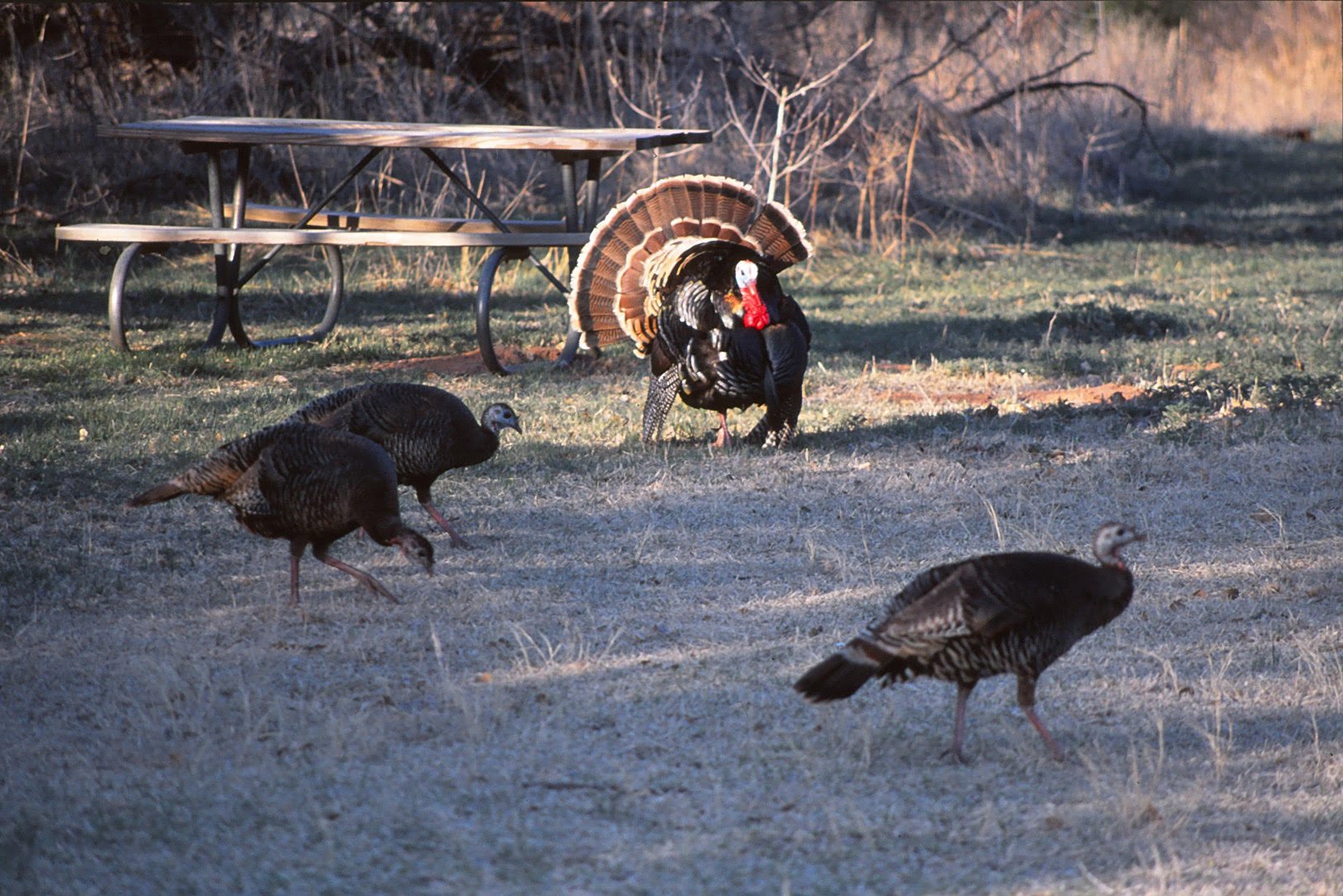February Nature Almanac: Roosting (Not Roasting!) Wild Turkeys
By Ruth Carol Cushman and Stephen Jones
February 2025
Wild Turkeys by the scores have been coasting down from a cliff to roost in large cottonwoods along the St. Vrain Creek in Lyons this winter. Raymond Davis, known to many Colorado birders for his hummingbird feeders, counted 134 turkeys on an evening in late January. Davis said they started arriving just as the light started to fade and were settled into the branches by dark.
This is just a fraction of the number of wild turkeys Raymond Davis saw flying in to roost. Photo by Raymond Davis
A week later, we had almost given up hope of seeing them as the moon and Venus came out big and bright. A Golden Eagle soared out from the cliff and disappeared into the western twilight. Only then did the first birds appear, and we estimated only 30 to 40 turkeys came in to roost that night. We speculated that, perhaps, they had remained hidden to avoid the eagle. The turkeys were quiet until suddenly a car siren screamed. Then, gobbling began. But soon they silently settled down for the night
A female Wild Turkey. Photo by Steve Jones.
During the day these huge members of the grouse family scrabble about on the ground for seeds, fruits, nuts, and insects, but at night they take to the trees to avoid predators. Unlike graceful Turkey Vultures, Wild Turkeys are clumsy flyers. The turkeys in Lyons benefit from starting at the top of a cliff, so they need only plummet down to the treetops. Occasionally, several plumped down on the same spindly branch, and we worried their weight would break the branch.
Mating season begins in May when the toms strut about and fan their tails to attract the ladies. You can gauge a male’s excitement by his head color, which changes from bright red to white to blue as passion rises. While the tom is busy posturing, some juvenile males may sneak in to mate with the hens.
None of the females seem to be a member of his fan club. Photo by Glenn Cushman
Nowadays Wild Turkeys are considered a nuisance in some places, but in the nineteenth and early twentieth centuries, they were hunted to near extinction. Numbers in the United States crashed to around 20,000 during the 1930s but have soared to around 7 million today. Reintroduction programs, hunting restrictions, habitat preservation, and control of disease spread from domestic poultry probably account for this remarkable recovery.
Colorado Division of Wildlife research suggests that Wild Turkeys were native to the scrub oak and piñon-juniper woodlands of southern Colorado but not to the northern half of the state. “Our” turkeys may actually be descended from game birds released here in the 1930s and 40s. Supplemental feeding by mountain homeowners probably helps the birds get through the winter.
A flock of turkeys can include multiple males. Photo by Steve Jones.
To see roosting Wild Turkeys, head to Lyons shortly before sunset. Remember that sunset gets later each day. Walk along the St. Vrain Creek to a spot where you see large cottonwoods south of the creek and a small cliff on the north side of Highway 36. Then wait.
R. Carol and Steve also do a monthly audio Nature Almanac program on KGNU on the first Friday of every month. So, if you want to listen to three birders as they wait for the turkeys to arrive, this program is archived on the BCNA website.
Other February Nature Events
Both Western and Eastern Bluebirds have been reported around the county this winter, and Mountain Bluebirds will soon start to return.
Easter daisies (Townsendia sp.) usually begin to bloom on shale slopes and magenta filarees (Erodium cicutarium, stork’s bill) on disturbed ground.
Great Horned Owls continue to sing duets and nest. You can tell the sexes apart because the female sings more notes at a higher pitch. (Listen to their songs on All About Birds)
Mourning cloak and Milbert’s tortoiseshell butterflies may emerge from crevices behind bark on warm days to feed on oozing sap.
Nature Almanac is a monthly series by Stephen R. Jones and R. Carol Cushman, along with other guest contributors. Ruth Carol Cushman and Stephen Jones are authors of A Field Guide to The North American Prairie (Peterson Field Guides) and Wild Boulder County: A Seasonal Guide to the Natural World.




